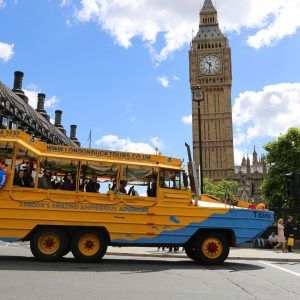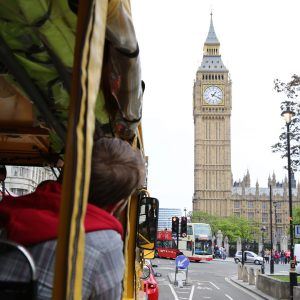A centre of arts, learning and culture that stands on The Strand halfway between the City of London and Trafalgar Square, Somerset House is a historic site where three royal palaces once stood. Today it provides a spectacular and unique venue for seasonal events such as fashion shows, ice skating and summer open air cinema. This is London Duck Tours favourite place to catch a classic movie in London!
It is open to visitors and large parts of the site are free to enter. Somerset House offers free guided tours on Tuesdays – ticket only, reserve in advance, and includes a tour of the Strand Lane Baths
Edward Seymour builds the first Somerset House
To truly appreciate the importance of the Somerset House site, London Duck Tours suggests looking further back in time.
From the 1200s to the 1700s the Strand area of London, was the location of choice for the key movers and shakers of the Royal Court. The child king, King Edward IV had a very ambitious Uncle Edward Seymour who appointed himself both Lord Protector and Duke of Somerset. He set about building himself a palace to rival the Royal residences. Work started in 1547 and in 1551 the grand and expensive Somerset House was complete at a cost of £10,000. However Seymour had little time to enjoy his new palace, as he was arrested for treason and executed on Tower Hill. Perhaps the Palace was just a bit too Royal and palatial for its own good?
Afterwards the building was given to the Crown, and occupied from 1553 to 1558 by Princess Elizabeth, the future Queen Elizabeth 1, whilst her sister Mary Tudor was on the throne. Throughout her lengthy reign Elizabeth continued to use Somerset House for occasional government meetings and as a convenient residence for foreign diplomats visiting her in London.
Never ending rebuilds
After Elizabeth I’s death in 1603, her successor James I gave Somerset House to his Danish wife Anne, who renamed the site Denmark House and staged grand parties, plays and masked balls, and spent a further £35,000 refurbishing and decorating the palace.
When Charles I came to the throne in 1625 he gave Denmark House to his wife Henrietta Maria and she commissioned further expensive reconstruction and redecoration by Inigo Jones. Henrietta fled the country at the outbreak of the civil war. She was to return to the House when her son Charles II came to the throne in 1660 – when she commissioned yet pricier redecoration and building works – that lady liked to spend!
Auction house for Royal Treasures
In the Civil War years “Denmark House” was used as the location for the Parliamentary Army’s auction of liberated the royal treasures. Works included almost 1800 paintings and tapesties by Leonardo, Raphael, Michelangelo, Correggio, Titian, Tintoretto, Holbein and Van Dyck, amongst others. Somerset House was also the location for the lying in state of Cromwell, who died in 1658.
Wife of the Merry Monarch
In 1685 yet another Queen, Catherine of Braganza took up permanent residence at Somerset House after the death of her husband Charles II. To overcome her grief she oversaw yet more redecoration, this time supervised by Sir Christopher Wren. Yet by the early 1700s and after years of rebuilding and redecorating the house was still in bad repair, and was falling into ruin. Unable to keep out the wind and rain of a London winter, George III decided to order the demolition of the ancient site in 1775.
The Modern Somerset House
Constructed over many years and in phases and after many design setbacks, the new Somerset house was built between 1776 and 1801, costing almost half a million pounds – an extraordinary sum for that period. The Strand block contained rooms for the learning of the polite arts, learned societies and for the display of elegant specimens!
The Royal Navy occupied a large section of the South Wing, with remaining three sides of the courtyard quad given to administrative departments. The famous sweeping winding Navy Staircase (later renamed the Nelson Stair) is located in this section. The Navy Staircase received a direct hit by an enemy bomb in 1940 but was painstakingly restored by Sir Albert Richardson.
Did you know?
The buildings, courtyard and fountains of Somerset House have been featured in several recent British TV series including Sherlock Holmes and Downton Abbey. The grand cobbled courtyard and its fountains have featured in two James Bond Films, Golden Eye and Tomorrow Never Dies plus many other feature films such as Bright Young Things, Last Chance Harvey and most recently action thrillers London Has Fallen and X-Men: First Class. As you can tell, London Duck Tours loves a movie!



















